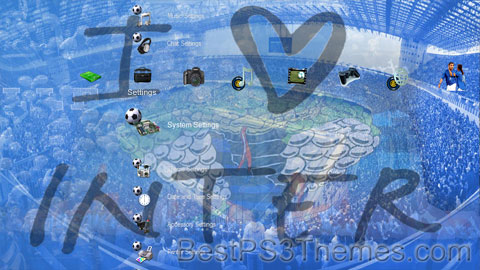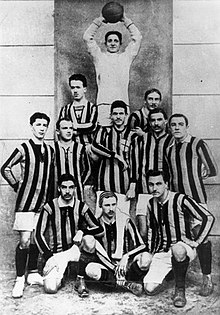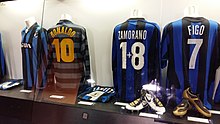Inter Milan theme by Yousef Khaja
Download: InterMilan.p3t

(2 backgrounds)
 | ||||
| Full name | Football Club Internazionale Milano S.p.A.[1][2] | |||
|---|---|---|---|---|
| Nickname(s) |
| |||
| Short name | Inter | |||
| Founded | 9 March 1908 (as Football Club Internazionale) | |||
| Ground | Stadio Giuseppe Meazza | |||
| Capacity | 75,817 (limited capacity) 80,018 (maximum) | |||
| Owner |
| |||
| Chairman | Giuseppe Marotta[4] | |||
| Head coach | Simone Inzaghi | |||
| League | Serie A | |||
| 2023–24 | Serie A, 1st of 20 (champions) | |||
| Website | Club website | |||
|
| ||||
Football Club Internazionale Milano, commonly referred to as Internazionale (pronounced [ˌinternattsjoˈnaːle]) or simply Inter, and colloquially known as Inter Milan in English-speaking countries,[5][6][7] is an Italian professional football club based in Milan, Lombardy. Inter is the only Italian side to have always competed in the top flight of Italian football since its debut in 1909.
Founded in 1908 following a schism within the Milan Foot-Ball and Cricket Club (now AC Milan), Inter won its first championship in 1910. Since its formation, the club has won 36 domestic trophies, including 20 league titles, nine Coppa Italia, and eight Supercoppa Italiana. From 2006 to 2010, the club won five successive league titles, equalling the all-time record at that time.[8] They have won the European Cup/Champions League three times: two back-to-back in 1964 and 1965, and then another in 2010. Their latest win completed an unprecedented Italian seasonal treble, with Inter winning the Coppa Italia and the Scudetto the same year.[9] The club has also won three UEFA Cups, two Intercontinental Cups and one FIFA Club World Cup.
Inter's home games are played at the San Siro stadium, which they share with city rivals AC Milan. The stadium is the largest in Italian football with a capacity of 75,817.[10] They have long-standing rivalries with Milan, with whom they contest the Derby della Madonnina, and Juventus, with whom they contest the Derby d'Italia; their rivalry with the former is one of the most followed derbies in football.[11] As of 2019,[update] Inter has the highest home game attendance in Italy and the sixth-highest attendance in Europe.[12] Since May 2024, the club has been owned by American asset management company Oaktree Capital Management.[13] Inter is one of the most valuable clubs in Italian and world football.[14]
History[edit]
Foundation and early years (1908–1960)[edit]

|
|
The club was founded on 9 March 1908 as Football Club Internazionale, when a group of players left the Milan Cricket and Football Club (now AC Milan) to form a new club because they wanted to accept more foreign players.[17] The name of the club derives from the wish of its founding members to accept foreign players as well as Italians.[18] The club won its first championship in 1910 and its second in 1920.[19] The captain and coach of the first championship winning team was Virgilio Fossati,[20] who was later killed in battle while serving in the Italian army during World War I.[21]
In 1922, Inter was at risk of relegation to the second division, but they remained in the top league after winning two play-offs.
Six years later, during the Fascist era, the club merged with the Unione Sportiva Milanese and, for political reasons, was renamed Società Sportiva Ambrosiana.[22] During the 1928–29 season, the team wore white jerseys with a red cross emblazoned on it; the jersey's design was inspired by the flag and coat of arms of the city of Milan.[23] In 1929, the new club chairman Oreste Simonotti changed the club's name to Associazione Sportiva Ambrosiana and restored the previous black-and-blue jerseys; however, supporters continued to call the team Inter, and in 1931 new chairman Pozzani succumbed to shareholder pressure and changed the name to Associazione Sportiva Ambrosiana-Inter.

Their first Coppa Italia (Italian Cup) was won in 1938–39, led by the Giuseppe Meazza, after whom the San Siro stadium is officially named. A fifth championship followed in 1940. After the end of World War II, the club's name changed back to its original one, Internazionale,[2] winning its sixth championship in 1953 and its seventh in 1954.
Grande Inter (1960–1967)[edit]
In 1960, manager Helenio Herrera joined Inter from Barcelona, bringing with him Spanish midfielder Luis Suárez, who won the European Footballer of the Year in the same year for his role in Barcelona's La Liga/Fairs Cup double.[24] He would transform Inter into one of the leading teams in Europe.[25] He modified a 5–3–2 tactic known as the "Verrou" ("door bolt"), which created greater flexibility for counterattacks.[26] The catenaccio system was invented by an Austrian coach, Karl Rappan.[27] Rappan's original system was implemented with four fixed defenders, playing a strict man-to-man marking system, plus a playmaker in the middle of the field, who plays the ball together with two midfield wings. Herrera would modify it by adding a fifth defender, the sweeper or libero, behind the two centre backs. The sweeper or libero, who acted as the free man, would deal with any attackers who went through the two centre backs.[28] Inter finished third in the Serie A in his first season, second the next year and first in his third season. Then followed a back-to-back European Cup victory in 1964 and 1965, earning him the title "il Mago" ("the Wizard").[28] The core of Herrera's team were the attacking full-backs Tarcisio Burgnich and Giacinto Facchetti, Armando Picchi the sweeper, Suárez the playmaker, Jair the winger, Mario Corso the left midfielder and Sandro Mazzola, who played on the inside-right.[29][30][31][32][33]

In 1964, Inter reached the European Cup Final by beating Borussia Dortmund in the semi-final and Partizan in the quarter-final.[34] In the final, they met Real Madrid, a team that had reached seven out of the nine finals to date.[34] Mazzola scored two goals in a 3–1 victory, and then the team won the Intercontinental Cup against Independiente.
A year later, Inter repeated the feat by beating two-time winner Benfica in the final held at home, from a Jair goal, and then again beat Independiente in the Intercontinental Cup, becoming the first European team to win two times in a row the competition. Inter came close to winning the Treble for the first time in European football history that year, after having also won the Serie A title, but lost the Coppa Italia final against Juventus.
Inter again reached semifinals of the European cup in 1966, but this time lost against a Real Madrid team that would go on to win the tournament.
In 1967, after Inter eliminated Real Madrid in quarterfinals, with Suárez injured, Inter lost the European Cup Final in Lisbon 2–1 to Celtic[35]. During that year, the club changed its name to Football Club Internazionale Milano.
Subsequent achievements (1967–1991)[edit]

Following the golden era of the 1960s, Inter managed to win their eleventh league title in 1971 and their twelfth in 1980.[36] Inter were defeated for the second time in five years in the final of the European Cup, losing 0–2 to Johan Cruyff's Ajax in 1972. During the 1970s and the 1980s, Inter also added two to its Coppa Italia tally, in 1977–78 and 1981–82.
Hansi Müller (1975–1982 VfB Stuttgart, 1982–1984 Inter Milan) and Karl-Heinz Rummenigge (1974–1984 Bayern Munich, 1984–1987 Inter Milan) played for Inter Milan. Led by the German duo of Andreas Brehme and Lothar Matthäus, and Argentine Ramón Díaz, Inter captured the 1989 Serie A championship. Inter were unable to defend their title, despite adding fellow German Jürgen Klinsmann to the squad and winning their first Supercoppa Italiana at the start of the season.
Mixed fortunes (1991–2004)[edit]
The 1990s was a lackluster period. While their great rivals Milan and Juventus were achieving success both domestically and in Europe, Inter enjoyed little success in the domestic league standings, their worst coming in 1993–94 when they finished just one point out of the relegation zone. Nevertheless, they achieved some European success, with three UEFA Cup victories, in 1991, 1994 and 1998.
With Massimo Moratti's takeover from Ernesto Pellegrini in 1995, Inter twice broke the world record transfer fee in this period (£19.5 million for Ronaldo from Barcelona in 1997 and £31 million for Christian Vieri from Lazio two years later).[37] However, the 1990s remained the only decade in Inter's history, alongside the 1940s, in which they did not win a single Serie A championship. This persistent lack of success led to poor relations between the fanbase and the chairman, the managers, and even some individual players.

Moratti later became a target of the fans, especially when he sacked the much-loved coach Luigi Simoni after a few games into the 1998–99 season, five days after Inter have defeated Real Madrid 3-1 at San Siro in Champions League group stage with two goals from Roberto Baggio, and having just received the Italian manager of the year award for 1998 the day before being dismissed. That season despite 4 coaches changes Inter reached Champions League quarter Finals when it will be eliminated from Manchester United; Inter failed to qualify for any European competition for the first time in almost ten years, finishing in eighth place.
In the previous season 1997-1998 under Simoni Inter had won his third UEFA Cup defending in Paris final Lazio 3-0, and nearly won Serie A title, with many controversial referee decisions culminated in the decisive match against Juventus in Turin with Inter behind only 1 point with 4 games left, when referee didn't concede a penalty on Ronaldo, that generated a turmoil on the pitch and a big scandal, with president Moratti that left the building shortly afterwards.
The following season 1999-2000, Moratti appointed former Juventus manager Marcello Lippi, and signed players such as Angelo Peruzzi, Laurent Blanc and Clarence Seedorf from Real Madrid, together with other former Juventus players Vieri and Vladimir Jugović and sold important players like Diego Simeone, and Gianluca Pagliuca. The team came close to their first domestic success since 1989 when they reached the Coppa Italia final, only to be defeated by Lazio, in a match remembered for the second severe injury on right knee of Ronaldo that was returning after 5 months of inactivity.
Inter's misfortunes continued the following season, losing the 2000 Supercoppa Italiana match against Lazio 4–3, after initially taking the lead through new signing Robbie Keane. They were also eliminated in the preliminary round of the Champions League by Swedish club Helsingborgs, with Álvaro Recoba missing a crucial late penalty. Lippi was sacked after only a single game of the new season following Inter's first ever Serie A defeat to Reggina. Marco Tardelli, chosen to replace Lippi, failed to improve results, and is remembered by Inter fans as the manager who lost 6–0 in the city derby against Milan.
In 2002 with new coach Hector Cuper, the acquisition of the second most expensive goalkeeper in the world at that time Francesco Toldo and the return after injury of Ronaldo in pair with Vieri, not only did Inter manage to make it to the UEFA Cup semi-finals, but were also only 45 minutes away from capturing the Scudetto when they needed to maintain their one-goal advantage away to Lazio. Inter were 2–1 up after only 24 minutes. Lazio equalised during first half injury time, and then scored two more goals by Simeone and Simone Inzaghi in the second half to secure victory that saw Juventus win the championship, Roma ended second and Inter third. After brillant performances and have won 2002 World Cup with Brazil, Ronaldo demanded and ottened to be sold to Real Madrid, and was replaced by Hernan Crespo from Lazio, Seedorf was sold to AC Milan and Fabio Cannavaro was acquired from Parma. The next season Inter finished as league runners-up and also reached the 2002–03 Champions League semi-finals against AC Milan, losing on the away goals rule with two draw in the same stadium in San Siro. Other members of the Inter "family" during this period who suffered were the likes of Vieri and Fabio Cannavaro, both of whom had their restaurants in Milan vandalised after defeats to the Rossoneri 3-2 on February 2004 in Serie A.
Comeback and unprecedented treble (2004–2011)[edit]

On 8 July 2004, Inter appointed former Lazio manager Roberto Mancini as its new head coach, with players that will make the history of Inter like Esteban Cambiasso, Julio Cesar, and in 2005 Walter Samuel and Luis Figo.[38] In his first season, the team collected 72 points from 18 wins, 18 draws and only two losses, as well as winning the Coppa Italia against Roma with two goal from Adriano and later the Supercoppa Italiana in Turin against Juventus.[39][40] On 11 May 2006, Inter won the Coppa Italia title for the second season in a row after defeating Roma with a 4–1 aggregate victory (a 1–1 scoreline in Rome and a 3–1 win at the San Siro).
